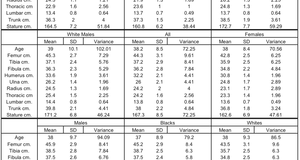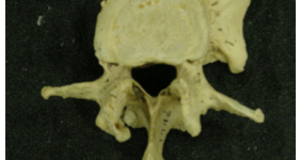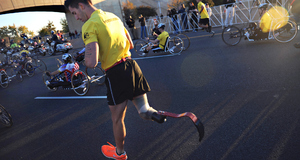From Discussions VOL. 8 NO. 2Ape Fracture Patterns Show Higher Incidence in More Arboreal SpeciesDiscussionThe numbers of fractures observed are artificially low because of the nature of museum specimen collection. These museum specimens were wild shot, meaning these numbers do not include those animals that fell from trees and died of their injuries, only those who survived their injuries. This also presents an artifact since some species may be better adapted to survive fractures than others. Since smaller animals are generally less likely to die from falls, they may have an artificially elevated fracture incidence in the museum population. When larger animals fall, they often die, so their skeletons would not reach a museum osteological collection. Therefore, proportions could reflect this difference rather than the differences in how often these apes fall, producing a selection bias. This could contribute to the higher incidence in gibbon fractures than in gorillas, although these rates also reflect the fact that gorillas spend less time in the trees due to their large bodies. As Bulstrode describes, the strength of bone is related to the severity of the penalty if it is broken (1990). Gorillas have very robust bones, so if they are fractured, it may be more devastating to the individual than if a gibbon breaks the same bone. This means more gibbons may be surviving with fractures, causing the wild shot populations to have many gibbons with fractures and fewer gorillas with fractures, since possibly a greater proportion of gorilla fractures are fatal. However, this does not necessarily in dicate that gibbons fall more, though it would make sense because they are both more arboreal and their elongated upper limbs may be more susceptible to random breaks upon falling. Gorillas likely have a lower proportion of upper limb fractures because they spend less time climbing trees than chimpanzees, so they have less risk of falling and causing trauma to the upper limb. This hypothesis was tested by analyzing gibbons, which are even more arboreal than chimpanzees, to see if they have even higher rates of fracture and particularly upper limb fracture. The gibbons did have higher rates of longbone fractures than chimpanzees in the Hamann-Todd Collection, although specimens from the Hamann-Todd Collection showed a much lower overall fracture incidence in chimpanzees compared to the literature values. The gibbons showed a smaller proportion of upper limb fractures compared to chimpanzees. The fragility of the gibbon skeleton might explain why gibbons had a lower proportion of upper limb fractures than chimpanzees. It was expected, since gibbons have very long upper limb bones, that they would have a greater proportion of upper limb fractures than chimpanzees, but the data show the reverse is true. The cause may be that since gibbons have smaller and more fragile skeletons, they are more prone to fractures of the lower limb caused by hitting branches while climbing. For chimpanzees, they may only suffer long bone fractures from falls, which more frequently break their upper limb bones. Their bones and muscles of the lower limb may be too strong to suffer from fractures through hitting branches while climbing. Since several gibbon specimens were observed to have fractures in the femur but not in the tibia or fibula, it is suspected that they sustain lower limb injuries from swinging through the trees more frequently than chimps and the other large apes. In humans, the upper limb is not nearly as robust but is much less used than the other apes due to bipedal locomotion. While bipedalism reduces the amount of upper limb fractures in humans, other behaviors contribute to high rates of fracture in modern humans, including sports and other activities that strain the human skeleton in ways it is not evolved to tolerate. Humans are evolved to use their upper limb to carry loads such as food collected to provision the family or to carry a dependent infant. Such use does not overly strain the upper limb, so in wild human populations, one would not expect much trauma to the human upper limb. The proportion of upper limb long bone fractures would most likely be much lower in a wild human population. In modern humans, injuries to the upper limb occur in many sports, including baseball and tennis, behaviors to which humans are certainly not adapted. Fractures of the upper limb were shown to vary based on sports in a study by Sinha and colleagues (1999), which showed fractures involving weight lifting (football, weight lifting, wrestling) had fractures distal to the elbow whereas throwers (pitchers, soccer goalie, javelin) had fractures in the shoulder girdle. Swingers (golf, tennis) had stress fractures in the lower ribs. This study shows how injuries to the upper limb are common in sports that require humans to use it in ways that they are not adapted for. A chimpanzee would have no problem pitching all day, since its upper limb is adapted to that type of motion (overhead suspension). Chimpanzees and present-day humans must be considered differently in their limb fractures since chimpanzees are living in the environment in which they evolved, whereas humans have relatively recently rapidly changed the stresses on their bodies. It would be interesting to study the upper limb fracture incidence in a wild human population. In humans, as bipedal animals, common injuries such as rotator cuff tears to the upper arm do not affect reproductive success as strongly as in quadrupedal animals. In a pair-bonding human, a fractured upper limb may mean the human could not hold as much food or as many babies, but he or she would still be able to locomote, gather food, and mate. In a chimp, upper limb fractures are much more serious, jeopardizing the ability of the animal to locomote at all, let alone find food or a mate. The relatively high rates of healed fractures in the apes (~20%) suggest that they must fall very often, since fatal falls are not accounted for, and that they are well-adapted to surviving despite fractures. Jane Goodall (1986) noted how often chimps fall from trees, observing 23 falls over 2990 hours in 1978 and 28 falls over 1975 hours in 1979. These values are lower than actual numbers, since not all falls could be observed. For adults, particularly males, most falls occurred during an instance of aggression with another chimpanzee, whereas infants fell most often while playing. Goodall recorded how chimps surviving injuries had limited abilities to locomote for weeks after the injury (1986). Nonhuman primates that sustain serious fractures must have some way to survive without use of their broken limbs, most likely through social relationships. Some evidence shows gibbons may pair bond (Geissman and Orgeldinger 2000), so a gibbon may provision food to its injured mate, allowing it to survive an injury that would otherwise kill it. Gender differences may also shed light on the causes of upper limb fractures. Male chimpanzees had a higher incidence of fractures than females, whereas the re verse was true for gorillas in Jurmain's study (1997). Male chimpanzees likely had higher rates of fracture due to aggression between males for access to females. The most commonly fractured bone in the chimpanzee skeleton is the ulna. As Jurmain (1997) describes, such fractures are called "parry fractures" in humans and are caused by raising the arm to block a blow. This suggests that chimpanzees are engaging in aggressive behavior that may also influence the distribution of their fractures. However, such fractures can also be caused by falls so it remains unclear whether one of these explanations or a combination of the two best reflects reality. For the gorillas, the cause of gender discrepancies is that females spend more time in the trees, making them more susceptible to falls, and therefore fractures. For gorillas, their body size makes climbing particularly risky, though they spend less time in the trees than chimpanzees and gibbons, which is reflected in their lower fracture incidence. Chimpanzees are adapted for living in the trees and there is very strong selection for chimpanzees that are good climbers, since falls are often fatal or debilitating enough to negatively impact reproductive success. Natural selection is always eliminating those who lack the agility or bone strength to avoid severe injuries. Those with stronger bones may be more likely to survive a fall or avoid a fracture, however, natural selection is confined by how strong chimpanzee bones can be before the weight of the bone and the resources required to make it are too great (Bulstrode, 1990). There will inevitably be a large amount of fractures caused by falls from trees as a consequence of non-human primates' adaptations to tree climbing. They are evolved in numerous ways, from the grasping hallux to the inflexible spine to the long upper limb bones, to be good climbers, a form of locomotion central to their way of life. Fractures from falling out of trees is a necessary consequence of life in the trees, but one which chimps can accept since the benefits of climbing trees so greatly outweigh the costs for them. Trees contain the food they eat and keep them safe from predators. Though it may be risky to climb trees, it may be more risky not to. AcknowledgementsI would like to thank Dr. Bruce Lat- imer for his guidance in conducting this research and the analysis of the results. I would also like to thank the Cleveland Museum of Natural History for allowing me to study their specimens in the Hamann-Todd Collection. ReferencesBulstrode, C. 1990. What Happens to Wild Animals with Broken Bones. Iowa Orthop J. 10: 1923. Donaldson, L., Cook, A., Thomson, R. 1990. Incidence of fractures in a geographically defined population. Journal of Epidemiology and Community Health. 44: 241-245. Geissmann, T., Orgeldinger, M. 2000. The relationship between duet songs and pair bonds in siamangs, Hylobates syndactylus. Animal Behaviour. 60: 805-809. Goodall, J. 1986. The Chimpanzees of Gombe: Patterns of Behavior. Harvard Univ. Press, Cambridge, Massachusetts. Jurmain, R. 1997. Skeletal Evidence of Trauma in African Apes, with Special Reference to the Gombe Chimpanzees. Primates. 38: 1-14. Lovell, N. C. 1990. Patterns of Injury and Illness in Great Apes. Smithsonian Institution Press, Washington, D.C. Meling, T., Harboe, K., Soreide, K. 2009 Incidence of traumatic long-bone fractures requiring in-hospital management: A prospective ageand gender-specific analysis of 4890 fractures. Injury, Int. J. Care Injured. 40: 12121219. Sinha, A., Kaeding, C., Wadley, G. 1999. Upper Extremity Stress Fractures in Athletes: Clinical Features of 44 Cases. Clinical Journal of Sport Medicine. 9: 199-202. Suggested Reading from Inquiries Journal
Inquiries Journal provides undergraduate and graduate students around the world a platform for the wide dissemination of academic work over a range of core disciplines. Representing the work of students from hundreds of institutions around the globe, Inquiries Journal's large database of academic articles is completely free. Learn more | Blog | Submit Latest in Biology |

















